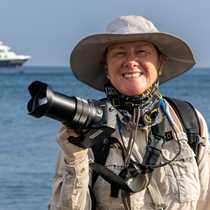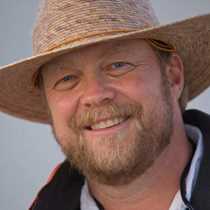By 5:45 a.m. the sky had enough light to see by, and the volcanoes of Isabela Island – the “seahorse” island – were passing by on the ship’s port side. On our starboard, Fernandina Island looming grandly, which meant we were travelling the famed Bolivar Channel, one of the most biodiverse marine regions on earth.
The morning hours were spent exploring an area known as Urvina Bay. In 1954 the region was uplifted 4 meters along a 5 kilometer stretch of coastline uplift. This action left what had been a shallow ocean floor exposed to an entirely different set of elements – air, sun and seasonal freshwater rainfall. The result is extraordinary. The trail took us past huge heads of coral, now grey with age, and some covered by vegetation. Into this area have penetrated terrestrial inhabitants to take over from the marine; yellow cordia trees, shrubs of Galápagos cotton and velvet-leaf – all being visited by our solitary carpenter bee who loves yellows and whites; and most fascinating for us, land iguanas sprawled across the trail, and one small, giant tortoise who showed itself only to a select few.
Back on the beach afterwards, while swimmers tested the waters, a Galápagos hawk dive-bombed a cattle egret – something none of the naturalists had seen before!
The afternoon sailing took us further north along the west coast of Isabela and into famous Tagus Cove, the perfect anchorage and well-known by all sea captains who sailed these waters throughout the centuries. Created by the ocean’s erosion into a volcanic tuff cone, the sandy bottom and protection from the wind outside in the Bolivar Channel, has created a calm place to spend an active afternoon.
And we took advantage of the circumstances! Zodiacs, kayaks, hikes and snorkels. Penguins were seen by those who went on the Zodiacs, flightless cormorants were both on shore and in the water, sea turtles were grazing the fields of sea weeds below, drifting in the surge, and those who chose the exercise option hiked up to the rim of a tuff cone for a splendid view over the fields of lava belonging to Darwin Volcano.
A full day in the western region of the archipelago – our last over here in the west, for tomorrow more adventures await us in the central islands.









